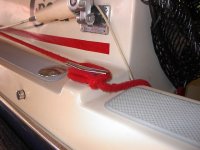jstates
New member
- Joined
- May 23, 2006
- Messages
- 225
- Reaction score
- 0
- C Dory Year
- 2000
- C Dory Model
- 22 Cruiser
- Vessel Name
- Endurance
Noticed some abrasion on my three strand dock lines [snubbers were on] that developed while at Blake Island this last week in a bit of a wind storm. I used one section of garden hose over line and around the 4x4 dock member to help. I had made all the lines from previous three strand anchor line that was on my boat at time of purchase.
Went to Cabelas and bought braided 3/8" lines - also purchased dock lines at West Marine - twice the price - there is a difference in the fullness and firmness of the line - Cabellas sheath very sloppy and core seemed smaller, compared to the twice as expensive at W Marine.
Having climbed for years where there are lots of climbing rope tests, what are the thoughts about braided vs three strand for the lines you carry with you. I read the WMarine information: braided more abrasion resistant, 3 strand perhaps more stretch per any diameter. I do plan on using braided for my short helm spring line that I use to back off dock due to less chance of catching on something.
I wonder if the spring lines in addition to using a snubber should be three strand due to more stretch and reduced instant load at either end. Are most folks with 22 using 3/8"?
If this has been discussed please point me to the links that I couldn't find in search for the last 45 minutes.
Thanks
Jim
[/img]
Went to Cabelas and bought braided 3/8" lines - also purchased dock lines at West Marine - twice the price - there is a difference in the fullness and firmness of the line - Cabellas sheath very sloppy and core seemed smaller, compared to the twice as expensive at W Marine.
Having climbed for years where there are lots of climbing rope tests, what are the thoughts about braided vs three strand for the lines you carry with you. I read the WMarine information: braided more abrasion resistant, 3 strand perhaps more stretch per any diameter. I do plan on using braided for my short helm spring line that I use to back off dock due to less chance of catching on something.
I wonder if the spring lines in addition to using a snubber should be three strand due to more stretch and reduced instant load at either end. Are most folks with 22 using 3/8"?
If this has been discussed please point me to the links that I couldn't find in search for the last 45 minutes.
Thanks
Jim
[/img]

